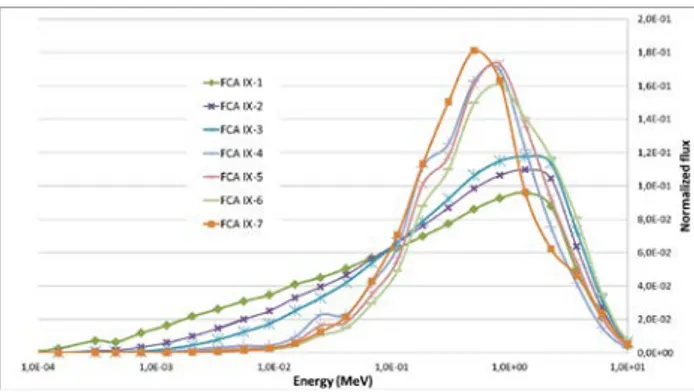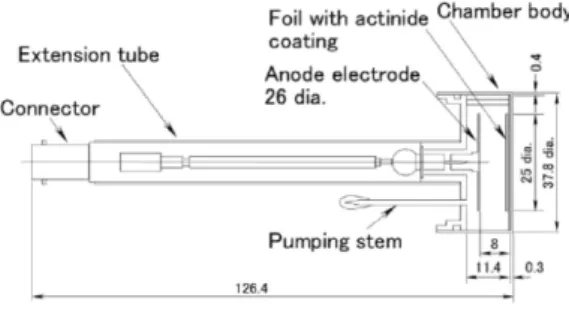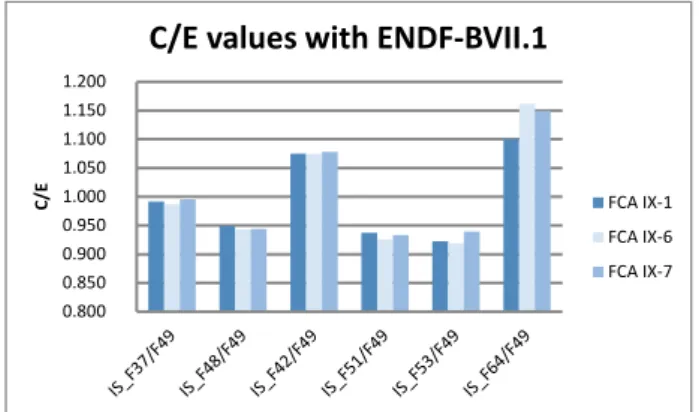HAL Id: cea-02438371
https://hal-cea.archives-ouvertes.fr/cea-02438371
Submitted on 14 Jan 2020
HAL is a multi-disciplinary open access
archive for the deposit and dissemination of
sci-entific research documents, whether they are
pub-lished or not. The documents may come from
teaching and research institutions in France or
abroad, or from public or private research centers.
L’archive ouverte pluridisciplinaire HAL, est
destinée au dépôt et à la diffusion de documents
scientifiques de niveau recherche, publiés ou non,
émanant des établissements d’enseignement et de
recherche français ou étrangers, des laboratoires
publics ou privés.
An in-depth analysis of Minor Actinide Fission
Chambers Measurements in the FCA IX Experimental
Programme.
G. Rimpault, V. Huy
To cite this version:
G. Rimpault, V. Huy. An in-depth analysis of Minor Actinide Fission Chambers Measurements in
the FCA IX Experimental Programme.. ND2016, Joint Research Centre, European Commission, Sep
2016, Bruges, Belgium. �cea-02438371�
An in-depth analysis of Minor Actinide Fission Chambers
Measurements in the FCA IX Experimental Programme.
Gérald Rimpault1,*and Virginie Huy1.
1
CEA, DEN, DER, SPRC, Cadarache, F-13108 St Paul-Lez-Durance, France
Abstract. FCA is a zero power facility located at Tokai in Japan. The FCA-IX experimental programme
exhibits 7 different cores with a variety of different neutron spectra. This has been achieved through the use of different moderators and different Uranium enrichments (93% for most of them except FCA-IX-7 where it is 20%). Fission Chambers of seven different nuclides: 237Np, 238Pu, 239Pu, 242Pu, 241Am, 243Am and 244 Cm were used to measure ratios of fission reaction rate. Mass quantitative determinations of the electrodeposited nuclides were carried out through spectral analysis using a surface barrier silicon detector and a pulse height analyzer. The quantitative determination errors for electrodeposited nuclides were 3% for 244
Cm and 1.5% for the other.
Uncertainties are calculated with COMAC V1 covariances associated for the JEFF32 library, with their own covariances for ENDF-BVII.1 and for JENDL4.0 libraries. The critical mass uncertainties are dominated by 235U capture contribution for JEFF3.1.1, JEFF3.2 and ENDF-BVII.1. However, uncertainties with JENDL4.0 are much lower due to a much reduced 235U capture contribution.
Calculated Uncertainty is mainly due to Nuclear Data Uncertainties and can be split into direct effect (Minor Actinide cross section) and indirect effect (through flux shape). The indirect effect is an important contribution to the total calculated effect (except for 238Pu): This is mainly due to 235U capture and that limits the possible feedback on the cross sections of minor actinides that have been measured through fission chambers. However, the fission rates of 237Np, of 243Am and 244Cm have a direct effect on significantly higher than those of the 235U and 239Pu in contrast to the 238Pu, 242Pu and the 241Am. The use of criticality measurements of these 7 cores can help reduce the magnitude of the indirect effect of 235U and therefore allow closer access to effective fission sections of the measured actinide fission chambers. All data sets exhibit the same trends with 242Pu and 244Cm fissions too large by around 10% while 241Am seems too small by 7%.
1 Introduction
FCA is a zero power facility located at Tokai in Japan. The FCA-IX experimental programme exhibits 7 different cores with a variety of different neutron spectra [1]. Fission Chambers of seven different nuclides:
237Np, 238Pu, 239Pu, 242Pu, 241Am, 243Am and 244Cm were
used to measure ratios of fission reaction rate [2]. This is a good opportunity for identify the correctness of Minor Actinides Fission cross sections.
2 FCA IX plant layout
FCA is a zero power facility located at Tokai in Japan. The FCA-IX experimental programme exhibits 7 different cores with a variety of different neutron spectra. This has been achieved through the use of different moderators and different Uranium enrichments (93% for most of them except FCA-IX-7 where it is 20%). In the following Figure 1, we can see the
normalized fission spectra as calculated with the TRIPOLI4 Monte Carlo code [3].
Figure 1. Normalised FCA-IX spectra
Given the relative similarities between most of the spectra, only FCA IX-1, FCA IX-6 and FCA IX-7 results have been reported in the following.
*
3
Criticality
Experimental values for criticality are given by JAEA [1]. Results of the analysis using TRIPOLI4 (T4) [3] and JEFF3.2 [7] are given in the following Table 1:
Table 1: E-C values for FCA IX critical masses using
TRIPOLI4 & JEFF3.2
One can see that there is a significant bias between JEFF3.2 calculations and experiments.
E-C as well as uncertainties on Keff have been calculated for different libraries. These use COMAC V1 covariances [6] for the JEFF32 library [7] and their own covariances for ENDF-BVII.1 [8] and for JENDL4.0 [9] (Table 2).
Table 2: E-C values for FCA IX critical masses using different libraries and associated covariances
The critical mass uncertainties are dominated by 235U
capture contribution for both JEFF3.2 and ENDF-BVII.1. However, uncertainties with JENDL4.0 are, in
general, much lower due to a much reduced 235U capture
contribution. Since C-E values are quite low with both
JEFF3.2 and ENDF-BVII.1, a 235U capture seems the
major suspect in the too high calculated reactivity level. Current trends on criticalities advocate for an increase of
235U capture for JEFF3.2 and ENDF B VII.1. An
assimilation technique will help identify which energy region is concerned.
4 Reaction Rates
Fission Chambers of seven different nuclides: 237Np,
238Pu, 239Pu, 242Pu, 241Am, 243Am and 244Cm were used to
measure ratios of fission reaction rate. Mass quantitative determinations of the electrodeposited nuclides were carried out through spectral analysis using a surface barrier silicon detector and a pulse height analyzer [2]. The quantitative determination errors for
electrodeposited nuclides were 3% for 244Cm and 1.5%
for the other. Figure 2 shows how these fission chambers are designed.
Figure 2: FCA-IX fission chambers
The detailed analyses of the Minor Actinide fission chambers measurements performed during the FCA-IX programme have been done using ERANOS2.3 [4]. Associated to the C/E values are the experimental uncertainty and the calculated one. This last one is dominated by nuclear data uncertainties and has been obtained with the sandwich formula using covariance matrices associated to JEFF3.2 libraries (COMAC V1) [6], and their own ones for ENDF-BVII.1 and JENDL4.0 libraries. Sensitivities were obtained with the GPT method [5] in ERANOS [4] (Table 3).
FCA IX-1 FCA IX-6 FCA IX-7 Experiment 1.00340 1.00250 1.00220 s exp (pcm) 240 60 70 T4 JEFF32 Heterogeneous 1.01438 1.01081 1.01122 s T4 (pcm) 7 7 6 E-C (pcm) -1079 -820 -890 s (pcm) 250 92 99
E-C (pcm) FCA IX-1 FCA IX-6 FCA IX-7
JENDL4.0 -1079 -307 -290 ND Uncertainty 724 606 811 ENDF-BVII.1 -548 -706 -1022 ND Uncertainty 2670 1789 1822 JEFF3.2 -1079 -820 -890 ND Uncertainty 2639 2143 2334
Table 3: C/E values for FCA IX fission rate ratios using JEFF3.2
This way of doing helps tracking the origin of nuclear data uncertainty in the calculation of measured fission rate ratios.
The fact that these cores are all enriched Uranium introduce an indirect effect due to the capture cross
section of 235U and that limits the possible feedback on
the cross sections of minor actinides that have been measured through fission chambers. However, the
fission rates of 237Np, of 243Am and 244Cm have a direct
effect significantly higher than those of the 235U and
239Pu in contrast to the 238Pu, 242Pu and the 241Am for
which information is diluted.
One can illustrate this with use of different covariance sets.
The use of COMAC V1 covariances for FCA IX
237Np/239Pu reaction rate ratio using the JEFF3.2 library
gives the following results (Table 4).
Table 4: Uncertainty breakdown for FCA IX-1
237
Np/239Pu reaction rate ratio using JEFF3.2
237
Np and 239Pu are direct contributions to the total
uncertainty while 235U is an indirect effect to the total
uncertainty. The situation is quite different for the same
reaction rate ratio 237Np/239Pu when using JENDL4.0
library (Table 5).
Table 5: Uncertainty breakdown for FCA IX-1
237
Np/239Pu reaction rate using JENDL4.0
One can notice that in this case, 235U contribution to the
total uncertainty is much reduced and that one can now
derive clear trends on 237Np fission cross-sections.
Given this, one can derive trends on cross sections being measured.
The C/E values for FCA IX fission rate ratios using JEFF3.2 are presented in the following Figure 3.
Figure 3: C/E values on FCA-IX fission rate ratios using JEFF3.2
Similarly, the C/E values for FCA IX fission rate ratios using JENDL4.0 and ENDF-BVII.1 are presented respectively in Figures 4 and 5.
JEFF3.2 FCA IX-1 FCA IX-6 FCA IX-7 IS_F37/F49 0.976 0.956 0.953 Exp Unc 0.022 0.019 0.024 Calc Unc 0.041 0.04 0.052 Total Unc 0.046 0.044 0.057 IS_F48/F49 1.144 0.978 0.987 Exp Unc 0.035 0.026 0.026 Calc Unc 0.018 0.02 0.023 Total Unc 0.039 0.033 0.035 IS_F42/F49 1.117 1.089 1.081 Exp Unc 0.022 0.019 0.024 Calc Unc 0.034 0.03 0.047 Total Unc 0.041 0.035 0.053 IS_F51/F49 0.954 0.927 0.909 Exp Unc 0.022 0.024 0.024 Calc Unc 0.031 0.027 0.05 Total Unc 0.038 0.036 0.055 IS_F53/F49 0.948 0.928 0.929 Exp Unc 0.022 0.024 0.024 Calc Unc 0.091 0.091 0.099 Total Unc 0.093 0.094 0.102 IS_F64/F49 1.092 1.13 1.091 Exp Unc 0.036 0.038 0.037 Calc Unc 0.052 0.053 0.067 Total Unc 0.063 0.065 0.077
COMAC V1 CAPTURE ELASTIC INELASTIC NU FISSION N,XN TOTAL Fe54 0.006 0.016 0.008 - - 0.000 0.019 Fe56 0.040 0.071 0.128 - - 0.000 0.152 Cr52 0.003 0.003 0.010 - - 0.000 0.011 Ni58 0.012 0.012 0.007 - - 0.000 0.018 Ni60 0.005 0.005 0.003 - - 0.000 0.008 C0 0.007 0.425 0.243 - - - 0.489 Np237 0.000 0.000 0.000 0.000 2.911 0.000 2.911 Pu239 0.000 0.000 0.000 0.000 1.588 0.000 1.588 U235 2.256 0.192 0.374 0.007 0.276 0.002 2.312 U238 0.282 0.074 0.117 0.015 0.126 0.000 0.339 TOTAL 2.274 0.478 0.479 0.016 3.330 0.002 4.089
JENDL4.0 CAPTURE ELASTIC INELASTIC NU FISSION N,XN TOTAL Fe56 0.047 0.085 0.490 - - 0.000 0.500 Cr52 0.001 0.012 0.029 - - 0.000 0.031 Ni58 0.005 0.008 0.016 - - 0.000 0.019 Ni60 0.001 0.002 0.007 - - 0.000 0.007 Np237 0.000 0.000 0.000 0.000 1.554 0.000 1.554 Pu239 0.000 0.000 0.000 0.000 0.538 0.000 0.538 U235 0.395 0.054 0.626 0.007 0.642 0.005 0.981 U238 0.080 0.102 0.066 0.016 0.010 0.004 0.147 TOTAL 0.406 0.146 0.798 0.017 1.766 0.006 1.985 0.800 0.850 0.900 0.950 1.000 1.050 1.100 1.150 1.200 C/ E
C/E values with JEFF3.2
FCA IX-1 FCA IX-6 FCA IX-7
Figure 4: C/E values on FCA-IX fission rate ratios using JENDL4.0
Figure 5: C/E values on FCA-IX fission rate ratios using ENDF-BVII.1
All data sets exhibit the same trends with 242Pu and
244Cm fission cross sections too large by around 10%
while 241Am fission cross section seems too small by
7%. Fission cross sections of 237Np and 243Am seems
correct, while statements on 238Pu fission cross section
has to wait an integral data assimilation work before drawing any conclusion.
5 Conclusions
7 FCA-IX cores offer a variety of neutron spectrum thanks to different moderators and enrichments.
FCA-IX-1 to FCA-IX-6 cores exhibit a 93% 235U enrichment
while FCA-IX-7 has 20% 235U enrichment.
The fact that these cores are all Uranium enriched cores
introduces an indirect effect due to 235U capture cross
section which somehow limits feedbacks on Minor Actinide cross sections being measured through fission
chambers at least for 238Pu, 242Pu and 241Am. This
conclusion comes from 235U covariances as they are
associated to JEFF3.2 (named COMAC V1) and ENDFB VII.1 files. The situation is quite different for JENDL4.0
for which 235U covariances are smaller by a factor 3. The
use of experimental keff for these 7 cores can help
reducing the magnitude of the 235U indirect effect of
JEFF3.2 and ENDF-BVII.1 and hence will allow having a refine access to MA fission cross sections though measured fission chambers.
The JEFF3.2 dominant uncertainty contributions are for each individual fission ratios from the nuclide itself
(direct effect), 239Pu (direct effect as used at the
denominator) and 235U (indirect effect mostly capture but
also inelastic and fission). For JEFF3.2, 237Np, 243Am
and 244Cm have a direct effect significantly larger than
the other 2 which means that the measurement can be used to validate their fission cross sections.
All data sets exhibit the same trends with 242Pu and
244
Cm fissions too large by around 10% while 241Am
seems too small by 7%. Although the 7 FCA-IX cores have different neutron spectra, this conclusion stands for all cores.
Acknowledgements go to JAEA who provided the detailed description of the benchmark and corrections to the raw experiments, to NEA who did provide the secretariat of the Expert Group on Improvement of Integral Experiments for Minor Actinide Management (EGIEMAM-II) under which this work has been conducted and EDF for providing funds to support Virginie Huy PhD work. I would like to thank the CEA fast reactor R&D project for supporting these activities.
References
1. Masahiro Fukushima, Yasunori Kitamura, Teruhiko Kugo & Shigeaki Okajima (2015): Benchmark models for criticalities of FCA-IX assemblies with systematically changed neutron spectra, Journal of Nuclear Science and Technology, DOI: 10.1080/00223131.2015.1054911.
2. Establishment of Benchmark Problems for TRU Fission Rate Ratios of FCA-IX Assemblies, M. Fukushima, A. Oizumi, H. Iwamoto, Y. Kitamura, Ref. JAEA-Data/Code/2014-030
3. J. P. Both et al. A survey of TRIPOLI4. In Int. Conf. on Radiation Shielding, 1994, Arlington, USA. 4. G. Rimpault and al., “The ERANOS Code and Data
System for Fast Reactor Neutronic Analyses”, Physor 2002, Seoul, Korea, (2002).
5. A. Gandini, “A generalized perturbation method for bilinear functional of the real and adjoint neutron
fluxes”, Journal of Nuclear Energy, 21 :755–765,
(1967).
6. C. De Saint Jean and al., “Estimation of multi-group
cross section covariance for 235U, 238U, 239Pu, 241Am,
56Fe, 23Na and 27Al”, PHYSOR 2012, Knoxville,
Tennessee, USA, April 15-20, 2012.
7. JEFF-3.2 evaluated data library - Neutron data ;
https://www.oecd-nea.org/dbforms/data/eva/evatapes/jeff_32/ , 2011
8. ENDF-BVII.1,
http://www.nndc.bnl.gov/endf-b-7.1.jsp , 2011
9. JENDL4.0, JAEA Data Center ;
http://wwwndc.jaea.go.jp/jendl/j40/update/index.ph p?order=date_a&filter=ponly, 2012 0.800 0.850 0.900 0.950 1.000 1.050 1.100 1.150 1.200 C/ E
C/E values with JENDL4.0
FCA IX-1 FCA IX-6 FCA IX-7 0.800 0.850 0.900 0.950 1.000 1.050 1.100 1.150 1.200 C/ E
C/E values with ENDF-BVII.1
FCA IX-1 FCA IX-6 FCA IX-7



